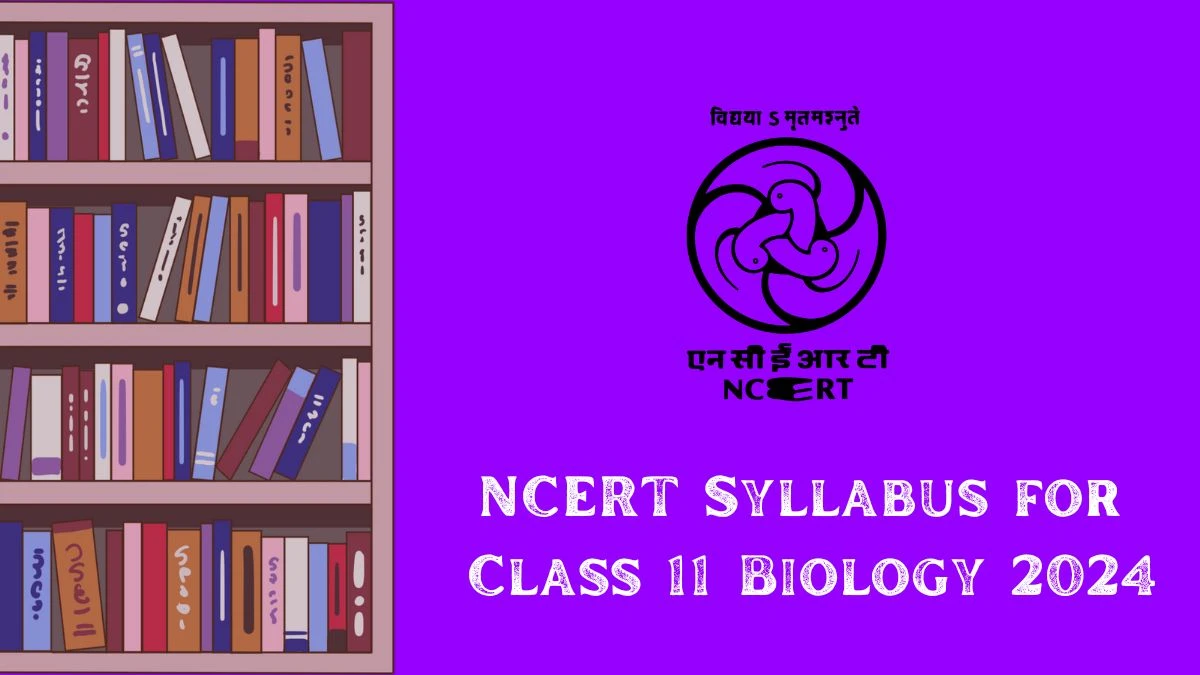- Rojgarlive »
- Education »
- NCERT Syllabus for Class 11 Biology 2024-25 at ncert.nic.in Download PDF Available Here
NCERT Syllabus for Class 11 Biology 2024-25 at ncert.nic.in Download PDF Available Here
by Keerthika
Updated Jun 13, 2024

NCERT Syllabus for Class 11 Biology 2024-25 at ncert.nic.in
The National Council of Educational Research and Training (NCERT) publishes the Class 11 Biology syllabus for 2024-25 on its official website, ncert.nic.in. The NCERT Biology syllabus for Class 11 includes all the topics and chapters that are part of the CBSE Class 11 curriculum. This syllabus is followed by CBSE and many other state boards. NCERT books, authored by top experts, are highly reliable.
Check - NCERT Syllabus for Class 11 Biology 2024-25
Unit-wise NCERT CBSE 11th Class Biology Syllabus
|
Unit no. |
Unit Name |
Chapters |
|
1 |
Diversity in Living World |
Chapter 1 : The Living World Chapter 2 : Biological Classification Chapter 3 : Plant Kingdom Chapter 4 : Animal Kingdom |
|
2 |
Structural Organisation in Plants and Animals |
Chapter 5 : Morphology of Flowering Plants Chapter 6 : Anatomy of Flowering Plants Chapter 7 : Structural Organisation in Animals |
|
3 |
Cell: Structure and Function |
Chapter 8 : Cell : The Unit of Life Chapter 9 : Biomolecules Chapter 10 : Cell Cycle and Cell Division |
|
4 |
Plant Physiology |
Chapter 11 : Photosynthesis in Higher Plants Chapter 12 : Respiration in Plants Chapter 13 : Plant Growth and Development |
|
5 |
Human Physiology |
Chapter 14 : Breathing and Exchange of Gases Chapter 15 : Body Fluids and Circulation Chapter 16 : Excretory Products and their Elimination Chapter 17 : Locomotion and Movement Chapter 18 : Neural Control and Coordination Chapter 19 : Chemical Coordination and Integration |
Practical Evaluation Scheme
|
Particular |
Marks assigned |
|
One Major Experiment Part A (Experiment No- 1,3,7,8) |
5 |
|
One Minor Experiment Part A (Experiment No- 6,9,10,11,12,13) |
4 |
|
Slide Preparation Part A (Experiment No- 2,4,5) |
5 |
|
Spotting Part B |
7 |
|
Practical Record + Viva Voce |
4 |
|
Project Record + Viva Voce |
5 |
|
Total |
30 |
List of Experiments
1. Study pollen germination on a slide.
2. Collect and study soil from at least two different sites and study them for texture, moisture content,
pH and water holding capacity of soil. Correlate with the kinds of plants found in them.
3. Collect water from two different water bodies around you and study them for pH, clarity and
presence of any living organisms.
4. Study the presence of suspended particulate matter in air at the two widely different sites.
5. Study of plant population density by quadrate method.
6. Study of plant population frequency by quadrate method.
7. Prepare a temporary mount of onion root tip to study mitosis.
8
8. To study the effect of the different temperatures and three different pH on the activity of salivary
amylase on starch.
Study/observation of the following (Spotting)
1. Flowers adapted to pollination by different agencies (wind, insect).
2. Pollen germination on stigma through a permanent slide.
3. Identification of stages of gamete development i.e. T.S. testis and T.S. ovary through permanent
slides (from any mammal).
4. Meiosis in onion bud cell or grass hopper testis through permanent slides.
5. T.S. of blastula through permanent slides.
6. Mendelian inheritance using seeds of different colour/size of any plant.
7. Prepared pedigree charts of genetic traits such as rolling of tongue, blood groups, widow’s peak,
colour blindness.
8. Exercise on controlled pollination – Emasculation, tagging and bagging.
9. Identification of common disease causing organisms like Ascaris, Entamoeba, Plasmodium,
ringworm through permanent slides or specimens. Comment on symptoms of diseases that they
cause.
10. Two plants and two animals found in xerophytic conditions. Comment upon their morphological
adaptations.
11. Plants and animals found in aquatic conditions. Comment upon their morphological adaptations.
NCERT Syllabus for Class 11 Biology 2024-25? - FAQ
The main advantage of class 11 syllabus of NCERT is that it clears the fundamental concept of the student for all the exams.
NCERT Class 11 syllabus is the foundation syllabus from which CBSE and other state boards derive their syllabus.




